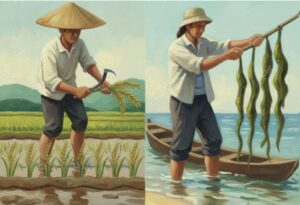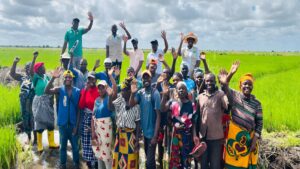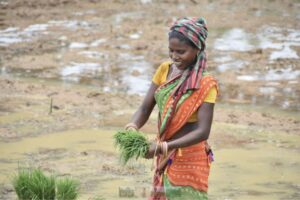
During the 1943 Bengal famine, 3 to 4 million people died because of widespread starvation. Since then, food security has been an important concern for India. For many years, the country had to sustain itself largely through imports. Moreover, it faced another dilemma when the population grew further. The introduction of newly developed semidwarf rice varieties in the 1960s helped India overcome such challenges to its food security, allowing the country to achieve rice-sufficiency and even become one of the major rice-producing countries today.
 The semidwarf modern varieties enabled India to substantially increase its rice production without considerably increasing the area for this production. Many recent modern rice varieties can be traced back to the original semidwarf ricevariety IR8, also known as “miracle rice,” which was developed by the International Rice Research Institute and released in India in the 1960s (see Breeding history on pages 34-38 of Rice Today Vol. 5, No. 4). A miracle indeed: the country’s rice production jumped from 31 million tons in 1950 to 111 million tons by 1990. By 2009, India produced 131 million tons of rice.
The semidwarf modern varieties enabled India to substantially increase its rice production without considerably increasing the area for this production. Many recent modern rice varieties can be traced back to the original semidwarf ricevariety IR8, also known as “miracle rice,” which was developed by the International Rice Research Institute and released in India in the 1960s (see Breeding history on pages 34-38 of Rice Today Vol. 5, No. 4). A miracle indeed: the country’s rice production jumped from 31 million tons in 1950 to 111 million tons by 1990. By 2009, India produced 131 million tons of rice.
India-IRRI partnership
IRRI began its partnership with India through the Indian Council for Agricultural Research (ICAR) in 1967. Indian scientists from the two main rice research centers of ICAR—the Central Rice Research Institute (CRRI) in Cuttack and the Directorate of Rice Research (DRR) in Hyderabad—regularly visited IRRI. In 1974, directors general M.S. Swaminathan and Nyle C. Brady of ICAR and IRRI, respectively, signed the first memorandum of understanding for cooperation in research and training.
This paved the way for the two institutions to sign work plans every 4 years, reviewing the progress of research and identifying opportunities and areas in which both could collaborate. The synergy in their partnership resulted in advancements in the development of disease- and insect-resistant varieties suited to various rice environments, the development and release of public- and private-bred hybrid rice varieties, streamlining of rice production practices for improved sustainability and productivity, and increased training and information exchange with Indian researchers. ICAR and IRRI have been working together since 2009 on 37 major initiatives that include projects such as Stress-Tolerant Rice for Poor Farmers of Africa and South Asia (STRASA), the Cereal Systems Initiative for South Asia (CSISA), and C4 rice. More than 80 institutes and organizations in India collaborate with IRRI in various areas of rice research.
Conservation and exchange of rice genetic materials
India has contributed 15,865 types of rice to the International Rice Genebank at IRRI, some of which have provided traits such as grassy stunt virus resistance from central Indian rice species Oryza nivara, which is useful in developing varieties that are resistant to submergence, salinity, pests, and diseases. In turn, IRRI gives Indian scientists access to its store of genetic materials, as well as those from other countries, for crop improvement. Up to 2010, more than 400 IRRI-bred lines had been either released as varieties for commercial cultivation in India or used in Indian breeding programs through the International Network for Genetic Evaluation of Rice (INGER).
Hybrid rice

For hybrid rice research, India and IRRI’s collaboration began in 1980. IRRI’s generous supply of hybrid rice breeding materials and its training support for its partners in the national agricultural research and extension systems (NARES) on hybrid rice technology laid a strong foundation for hybrid rice research in India.
NARES researchers’ concerted efforts, technical backstopping, access to IRRI’s genetic materials, and generous funding from donors allowed India to become the second country in the world, after China, to commercialize hybrid rice. The first set of hybrids was released in 1994 and, by 2010, 43 hybrids had been released in the country (see Hybridizing the world). More than 70% of these hybrids have either one or both parents bred at IRRI. Because of the effective use of rice breeding materials, hybrid rice has been developed and disseminated rapidly in India. Today, hybrid rice occupies about 1.4 million hectares in the country and is poised for significant growth.
Rice production and management
Collaborative research between India and IRRI has greatly helped in streamlining rice production practices to make rice production not only profitable but also sustainable and environment-friendly.
Some of these practices are resource-conserving technologies (laser-aided land leveling, zero or minimum tillage, drill and drum seeding, nitrogen fertilizer management using a leaf color chart), integrated weed management practices for direct-seeded rice, and integrated crop management practices.
Toward the future
India will be one of the most important partner countries for the Global Rice Science Partnership (GRiSP) . At present, some 170 partnerships exist between IRRI and Indian institutions and organizations. This includes over 40 research institutions belonging to the ICAR system, universities, and others. ICAR will act as a nodal point for GRiSP research activities in India. Science capacity, including scholarships, internships, and short courses, will also be a major component of GRiSP–India collaboration. IRRI and India promise to work together in the next 10 years—and even beyond—on areas of mutual relevance, in which good science and collaboration will make significant strides. India, with its diverse rice ecologies and large capacity in scientific human resources, will continue to play a key role in IRRI’s agenda. India is interested in partnering on initiatives that include C4 rice. Other areas in which India and IRRI will be working together are innovative public-private partnerships to deliver technologies to farmers through CSISA and rice varieties improved against drought, submergence, and salinity for farmers in rainfed areas through STRASA. IRRI foresees that, in the next 2 years, more stress-tolerant rice varieties that include not only submergence and drought tolerance but also salinity tolerance will be released in India.
_________________________________________
Ms. Ferrer is a writer at IRRI.









